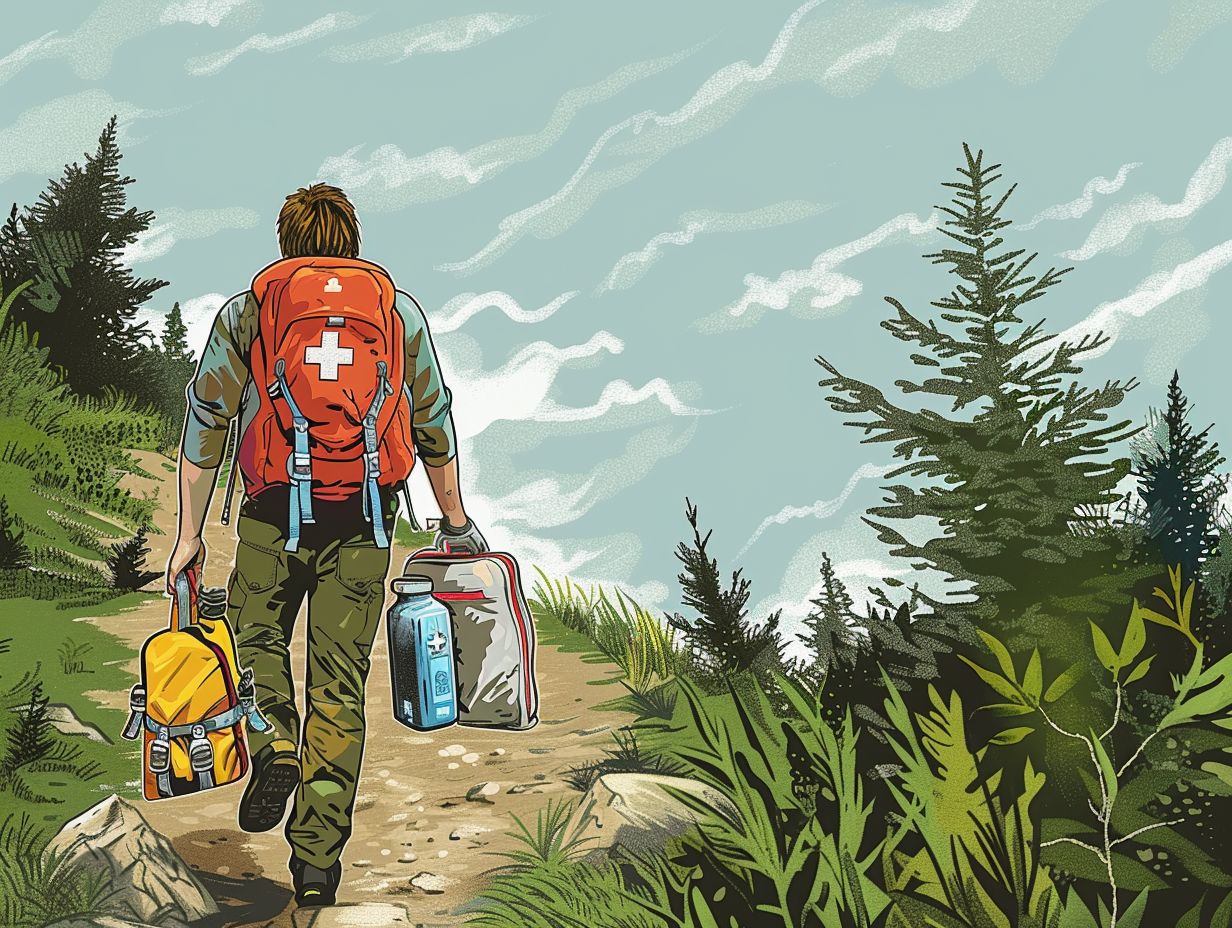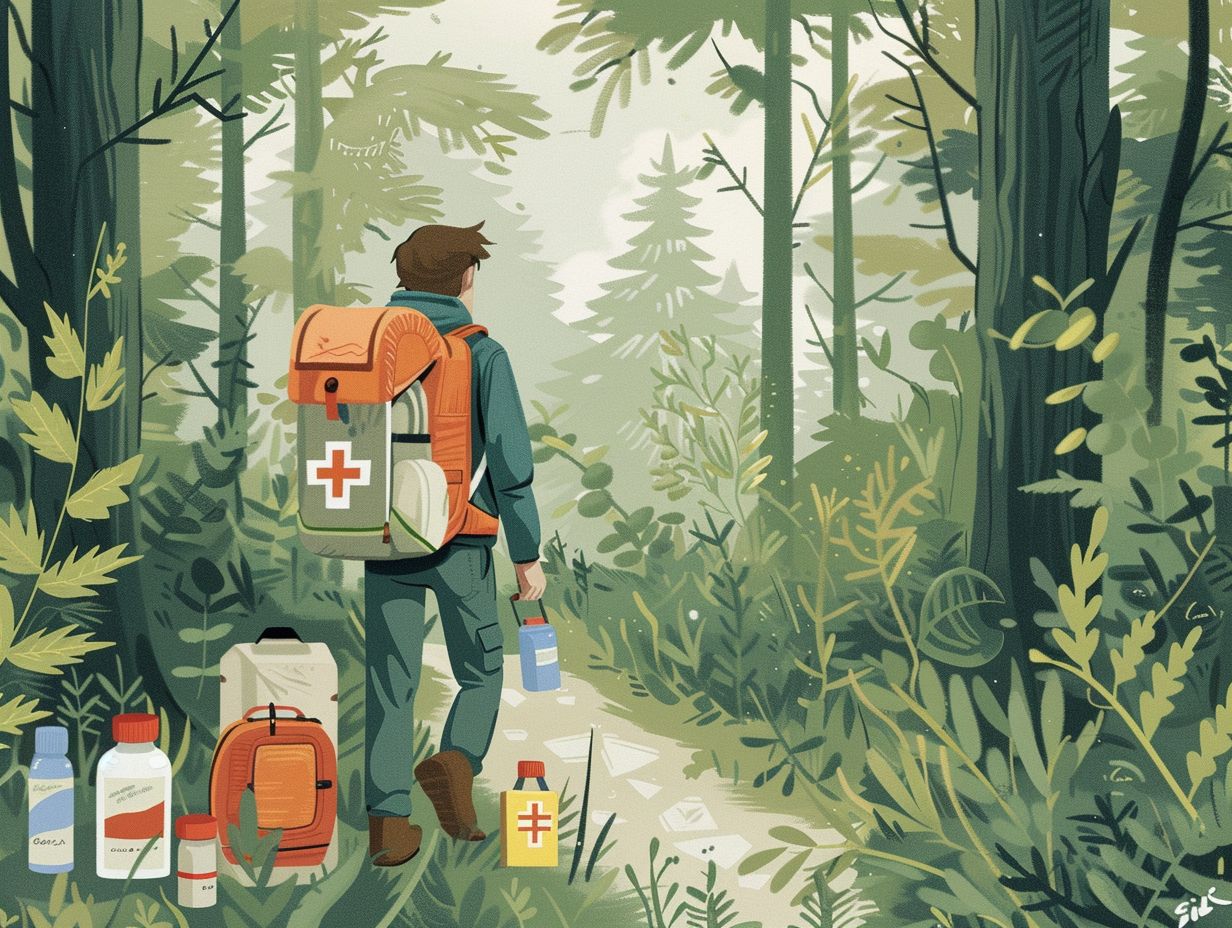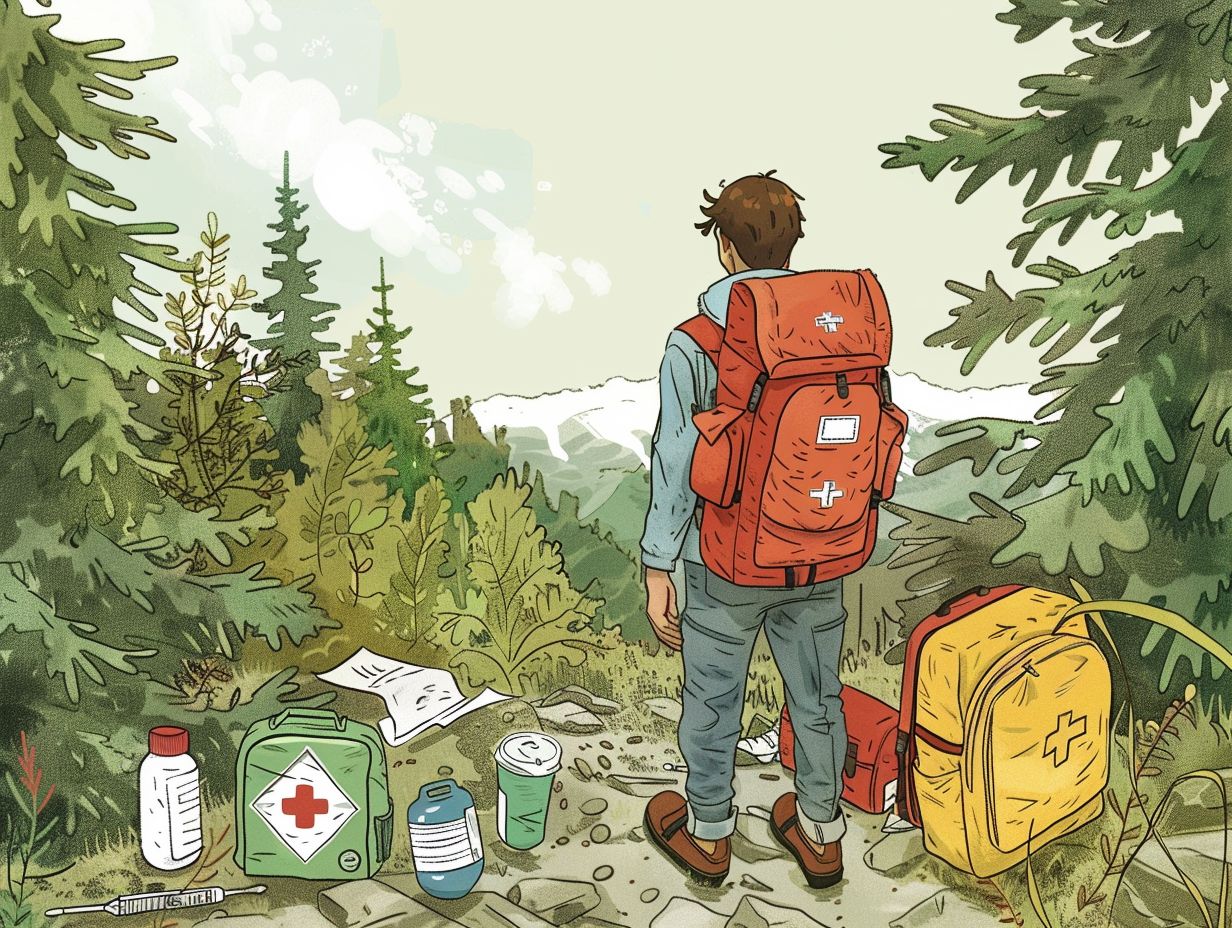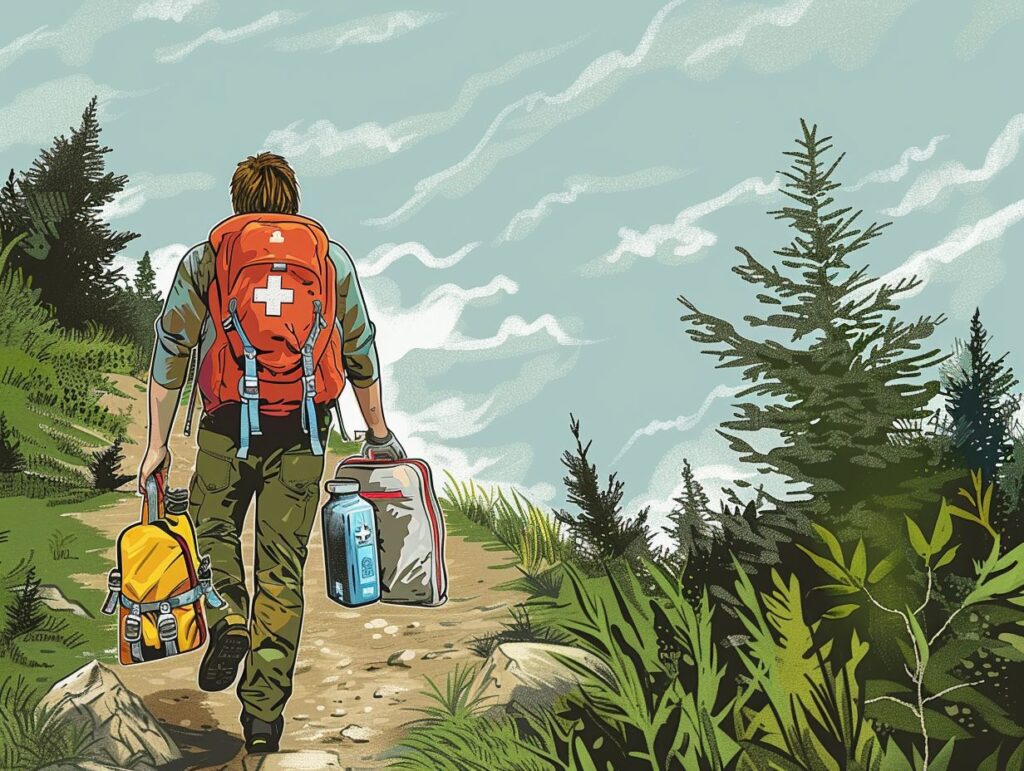Hiking is a popular outdoor activity that allows you to connect with nature and stay active. It’s crucial to be aware of potential injuries that can occur while out on the trail.
From sprains and blisters to sunburns and insect bites, understanding how to prevent and treat these common hiking injuries is essential for a safe and enjoyable experience.
We will discuss the various types of hiking injuries, prevention methods, on-trail treatment, when to seek medical attention, and proper recovery techniques.
So, lace up your boots and hit the trail!
Key Takeaways:

- Proper gear and clothing are essential in preventing common hiking injuries such as sprains, blisters, and sunburns.
- Warm up, stretch, and know your limits to avoid strain and exhaustion on the trail.
- In case of an injury, rest and treat with ice, bandages, and proper first aid techniques before seeking medical attention.
Types of Hiking Injuries
Injuries sustained while hiking can range from inconsequential annoyances to significant health hazards, affecting individuals who take part in wilderness excursions. A comprehensive understanding of these injuries is essential for individuals who participate in outdoor activities, as it enables them to foresee potential risks and handle them skillfully in the face of challenges posed by nature.
1. Sprains and Strains
Twists and sprains are common occurrences in hiking expeditions, with the ankles being particularly vulnerable to injury due to the uneven terrain and sudden movements. These kinds of injuries can lead to discomfort, swelling, and limited movement, creating difficulties in continuing along the hiking path.
To reduce the likelihood of such incidents, it is crucial to use suitable hiking boots that offer ankle support and stability. Moreover, the use of walking poles can help in distributing weight and providing balance, reducing the chances of suffering from strains and sprains.
Whether someone is an experienced walker or just starting this outdoor pursuit, following these preventive measures can greatly improve the overall hiking experience.
2. Blisters
Blisters are a common inconvenience experienced by hikers, frequently attributed to friction between the skin and poorly fitting hiking boots. When the skin is subjected to repetitive rubbing or pressure, it reacts by developing a protective fluid-filled blister. These fluid-filled sacs can induce significant discomfort, impeding the hiker’s ability to continue their trek. Typical indications of blisters include redness, swelling, and tenderness.
Promptly addressing blisters is imperative to prevent infection. Initial first aid measures involve cleansing the blister with mild soap and water, followed by the application of a sterile dressing or moleskin to protect the affected area.
Ensuring that hiking boots are correctly sized can significantly reduce the likelihood of blister formation, highlighting the importance of properly fitting footwear. Moreover, wearing moisture-wicking socks and using friction-reducing products can help to proactively prevent blister development during hiking trips.
3. Sunburns
Sunburns pose a significant risk to individuals engaged in extended outdoor activities, particularly hikers, who are exposed to the sun without adequate protection for prolonged periods. Exposure to ultraviolet (UV) radiation not only results in skin damage but also heightens the likelihood of developing skin cancer over time.
Common symptoms of sunburn encompass redness, pain, swelling, and in severe cases, blistering of the affected skin. It is imperative to promptly alleviate these symptoms by employing cooling compresses, applying soothing lotions like aloe vera, and maintaining proper hydration.
Furthermore, the adoption of preventive measures, such as the application of sunscreen with a high Sun Protection Factor (SPF), donning protective clothing including wide-brimmed hats, and utilising UV-blocking sunglasses, plays a crucial role in mitigating the risk of sunburn and averting long-term skin damage.
4. Insect Bites and Stings
In the wilderness, insect bites and stings are a common occurrence that can vary in severity from minor irritation to severe allergic reactions. When traversing through nature, individuals may come across a variety of insects such as mosquitoes, ticks, bees, wasps, and ants, all capable of inflicting painful bites or stings.
Symptoms associated with insect bites and stings may manifest as redness, swelling, and itching, or escalate to more serious reactions like respiratory distress, lightheadedness, and in extreme instances, anaphylaxis.
It is imperative for hikers to possess a fundamental understanding of first aid protocols for treating insect bites and stings, which includes cleansing the affected area, applying ice to mitigate swelling, and utilising over-the-counter antihistamines or hydrocortisone cream.
Individuals with known allergies to insect venom should always carry an epinephrine auto-injector as a precaution against potentially life-threatening allergic responses.
5. Dehydration
Dehydration poses a significant risk to hikers, particularly in hot environments or during physically demanding activities.
This condition arises when the body expels more fluid than it absorbs, resulting in an electrolyte imbalance crucial for sustaining proper bodily functions. Typical symptoms indicative of dehydration encompass thirst, dry mouth, darkened urine, fatigue, dizziness, and cognitive disorientation.
Maintaining adequate hydration levels is vital for optimising physical performance and promoting overall well-being. The consumption of a sufficient quantity of water and integration of electrolyte-rich foods or beverages into one’s diet can serve as preventive measures against dehydration.
Attentiveness to the body’s cues and prompt replenishment of lost fluids are imperative to mitigate the potential consequences linked to dehydration.
6. Heat Exhaustion and Heat Stroke

Heat exhaustion and heat stroke are serious medical conditions that can impact individuals who are exposed to high temperatures. Heat exhaustion is characterised by symptoms such as heavy sweating, rapid pulse, nausea, weakness, and clammy skin.
In contrast, heat stroke is a more severe condition that can manifest as confusion, dizziness, a throbbing headache, and even loss of consciousness. It is imperative to distinguish between the two, as heat stroke necessitates immediate medical intervention.
The initial approach to treating heat exhaustion involves relocating the individual to a cool environment, loosening their clothing, and administering hydration through water or sports drinks.
In cases of heat stroke, emergency services should be contacted without delay, the individual should be moved to a cooler location, and their body can be cooled using ice packs or damp cloths while awaiting professional assistance.
Preventing Hiking Injuries
Preventing hiking injuries is essential to ensure a safe and enjoyable outdoor experience. This entails careful preparation, the use of appropriate gear, and a thorough understanding of one’s physical abilities.
1. Proper Gear and Clothing
It is imperative to wear appropriate gear and attire to mitigate hiking injuries and ensure comfort while on the trail.
The selection of suitable hiking boots, clothing, and equipment can significantly influence the quality of your hiking expedition. Poorly fitting boots may result in blisters and discomfort, while well-fitted footwear offers stability and grip, thereby reducing the likelihood of slips and falls.
Opting for moisture-wicking attire aids in regulating body temperature and prevents chafing. A properly fitted rucksack with adequate weight distribution can help prevent strain on the back and shoulders. Investing in high-quality gear not only enhances safety precautions but also enables individuals to fully appreciate the natural beauty of outdoor environments.
2. Warm Up and Stretching
Warming up and stretching before setting off on a hike can play a crucial role in reducing the risk of sprains and strains.
Engaging in a comprehensive warm-up routine serves to promote increased blood circulation to the muscles, thereby enhancing flexibility and range of motion. By adequately preparing the body for physical exertion, individuals can optimise their overall performance and mitigate the chances of sustaining injuries.
The incorporation of dynamic stretching exercises such as leg swings, arm circles, and lunges can serve to further alleviate tension in tight muscles and joints.
These dynamic movements assist in conditioning and priming the body for the physical demands associated with hiking, consequently enabling individuals to navigate challenging terrains with greater ease and a reduced likelihood of experiencing discomfort or injury.
3. Know Your Limits
It is imperative for hikers to understand and acknowledge their physical limitations in order to mitigate risks such as dehydration, altitude sickness, and other potential injuries.
Maintaining self-awareness is a critical component in ensuring a safe and enjoyable hiking expedition. By attentively monitoring the signals your body sends and recognising when it is necessary to pause and rest, you can prevent the likelihood of exceeding healthy physical boundaries.
Identifying symptoms of dehydration, such as dry mouth and light-headedness, enables you to promptly address the issue, thereby averting more severe repercussions. Similarly, remaining mindful of indicators of altitude sickness, including headaches and nausea, can act as an early warning to descend to lower elevations before the condition escalates.
Taking breaks as needed not only rejuvenates the body but also minimises the risks of overexertion and potential physical harm.
4. Stay Hydrated and Fueled
Maintaining adequate hydration and sustenance is imperative for hikers to preserve energy levels and prevent dehydration.
Water serves a critical role in regulating body temperature, facilitating joint lubrication, and transporting nutrients to cells. Electrolytes, such as sodium, potassium, and magnesium, are essential for maintaining optimal muscle function and hydration levels.
During the course of a hike, it is advised to consume water regularly, preemptively rather than in response to thirst, as dehydration can significantly impact both performance and overall well-being.
Carrying a hydration pack or water bottle is recommended to ensure convenient access to water throughout the trek. Additionally, incorporating snacks such as nuts, fruits, and energy bars can aid in replenishing electrolytes and providing sustained energy levels during extended hikes.
Treating Hiking Injuries on the Trail
Providing prompt and effective treatment for hiking injuries while on the trail can have a substantial impact on the speed of recovery and overall comfort, thereby preventing minor ailments from developing into more serious issues.
1. Rest and Ice

Rest and ice are pivotal treatments for sprains and strains, playing a crucial role in reducing inflammation and alleviating pain. When engaging in outdoor activities, it is imperative to possess the knowledge on how to effectively administer rest and ice therapy to injuries in order to expedite the recovery process.
Allowing the affected area adequate time for rest facilitates tissue healing, while the application of ice aids in the constriction of blood vessels and the reduction of swelling. It is important to note that elevating the injured area above heart level can further assist in the reduction of inflammation.
It is advised to ice the affected area for 15-20 minutes every 2-3 hours within the initial 48 hours following the injury. Utilising a proper barrier, such as a towel, between the ice pack and the skin is essential to prevent ice burns.
2. Bandages and Blister Treatment
Appropriate management of blisters using plasters can help prevent infection and enable hikers to continue their journey with minimal discomfort.
For outdoor enthusiasts, it is imperative to carry a first aid kit containing supplies for treating blisters. The process of cleaning a blister involves gently washing the affected area with mild soap and water, ensuring thorough drying by patting it dry.
Subsequently, applying a plaster specifically designed for blisters or utilising moleskin to shield the area and reduce friction is recommended. Regular inspection and replacement of the plaster are essential to uphold cleanliness and avert potential complications.
Adherence to these basic procedures can significantly enhance the maintenance of comfort and safety during outdoor excursions.
3. Sun Protection
Sun protection plays a vital role in the prevention of sunburns, which not only cause significant discomfort but can also lead to lasting skin damage. Utilising sunscreen with a high Sun Protection Factor (SPF) is an essential measure, along with the use of protective clothing like hats, sunglasses, and long-sleeved shirts to offer added defence against harmful ultraviolet (UV) rays.
It is recommended to seek shade during peak sun hours, typically observed between 10 a.m. and 4 p.m. In case of a sunburn, applying cool compresses and moisturisers can help to alleviate the discomfort experienced. Maintaining hydration by consuming an adequate amount of water and using over-the-counter pain relievers can further ease the symptoms.
In cases of severe sunburn, seeking medical attention is imperative for appropriate treatment and to prevent any potential complications.
4. First Aid for Insect Bites and Stings
The administration of first aid for insect bites and stings can effectively alleviate pain and prevent allergic reactions from worsening.
If an individual has been bitten or stung, the initial step is to remove the stinger if it remains embedded in the skin. Following this, washing the affected area with soap and water is recommended to minimise the risk of infection. Utilising a cold compress or ice pack can aid in reducing swelling and alleviating pain.
It is important to remain vigilant for indications of an allergic reaction, such as swelling extending beyond the bite site, breathing difficulties, or an elevated heart rate. In severe instances, the availability of antivenom or allergy medication is crucial, particularly for individuals prone to severe reactions.
When to Seek Medical Attention?
Understanding the appropriate time to seek medical attention holds paramount importance for hikers, as certain injuries necessitate professional care to mitigate the risk of further complications.
If an individual experiences persistent pain, swelling, or an inability to bear weight on a limb subsequent to a fall or twist, this may be indicative of a fracture.
Observing symptoms such as dizziness, confusion, or loss of consciousness following a head injury should serve as red flags, prompting an immediate need for medical assistance.
Instances involving severe bleeding unresponsive to pressure application, or difficulties in breathing accompanied by chest pain, should prompt the individual to not hesitate in contacting emergency services.
Timely medical intervention plays a critical role in averting enduring damage and ensuring a prompt recovery.
Recovering from Hiking Injuries
The process of recuperating from hiking injuries necessitates a comprehensive approach that includes sufficient rest, proper nutrition, and, sometimes, physiotherapy to enable a full and prompt recovery.
1. Rest and Proper Nutrition
Rest and proper nutrition play a critical role in the recovery process, enabling the body to repair and rebuild its strength effectively. During periods of rest, the body undergoes essential processes such as repairing damaged tissues, replenishing energy reserves, and fortifying the immune system.
It is imperative to complement rest with a well-balanced diet that is rich in nutrients conducive to healing. Foods that are high in protein, such as lean meats, fish, and legumes, are particularly beneficial for tissue repair, while fruits and vegetables supply vital vitamins and antioxidants that promote overall health.
Additionally, whole grains and nuts provide sustained energy levels that are essential for the body’s recovery journey.
A diet that is comprehensive and diverse ensures that the body receives the requisite vitamins, minerals, and nutrients necessary to facilitate a prompt and efficient recovery process.
2. Physiotherapy

Physiotherapy serves as a crucial element in the rehabilitation process, playing a significant role in enhancing mobility and strength post-hiking injuries.
It is highly recommended for individuals who have sustained musculoskeletal injuries, including sprains, strains, or fractures. The advantages of physiotherapy encompass enhancements in range of motion, pain reduction, and preventative measures against further injury.
Common exercises employed during physiotherapy sessions comprise stretching, strengthening, and balance exercises. Additionally, treatments such as manual therapy, ultrasound, and electrical stimulation may be integrated to facilitate the healing trajectory.
The overarching objective of physiotherapy is to tailor a treatment regimen specific to an individual’s requirements and objectives, thereby expediting a swifter and more efficacious recovery process.
Frequently Asked Questions
What are the most common hiking injuries?
The most common hiking injuries include sprains, strains, blisters, sunburn, and insect bites.
How can I prevent blisters while hiking?
To prevent blisters, it is important to wear proper fitting shoes and socks, break in new shoes before a long hike, and use moleskin or blister pads on areas that are prone to blistering.
What should I do if I sprain my ankle while hiking?
If you sprain your ankle while hiking, immediately stop and rest. Apply ice to the area to reduce swelling, elevate your leg, and wrap it with a compression bandage. If the pain persists, seek medical attention.
What is the best way to treat a sunburn while hiking?
The best way to treat a sunburn while hiking is to immediately seek shade and apply aloe vera or a cool compress to the affected area. Make sure to stay hydrated and avoid further sun exposure.
How can I prevent insect bites while hiking?
To prevent insect bites, wear insect repellent and cover exposed skin with long clothing. Avoid using scented products and take necessary precautions in areas known for high insect activity.
What should I do if I encounter a snake while hiking?
If you encounter a snake while hiking, remain calm and give the snake space to move away. Do not try to handle or harm the snake. If you are bitten, seek medical attention immediately.

